
Cell Therapy Technologies Market Size, Growth, Share & Trends Analysis
Cell Therapy Technologies Market by Product (Media, Sera, Reagents, Vessels, Equipment), Process (Expansion, Isolation, Characterization, Collection, Preservation, Distribution, QC), Type (T-cells, Stem Cells), Application (Cancer) - Global Forecast to 2030




OVERVIEW
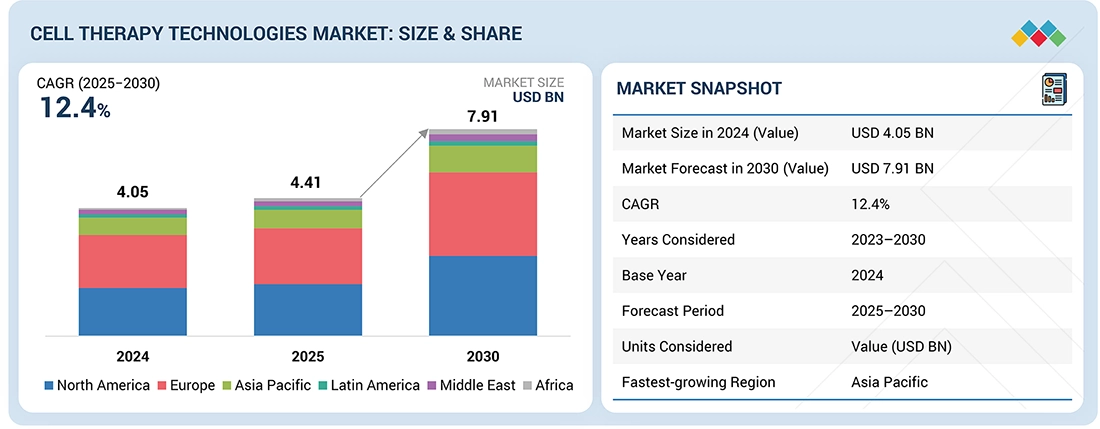
Source: Secondary Research, Interviews with Experts, MarketsandMarkets Analysis
The cell therapy technologies market is projected to reach USD 4.41 billion from 2025 to USD 7.91 billion by 2030, at a CAGR of 12.4% from 2025 to 2030. The growth of the cell therapy technologies market is driven by the expanding base of approved CGTs and a growing clinical pipeline, rising investment in cell and gene therapy R&D. Focus on the development of platformized, modular manufacturing solutions for autologous therapies is a key opportunity area in the market.
KEY TAKEAWAYS
-
By RegionThe North America cell therapy technologies market dominated, with a share of 38.8% in 2024.
-
By Product TypeBy product, the media, sera and reagents segment dominated, with a share of 47.5% in 2024.
-
By ProcessBy process, the cell processing segment dominated, with a share of 72.9% in 2024.
-
By Cell typeBy cell type, the T-cells segment will grow the fastest during the forecast period.
-
By ApplicationBy application, the cancer segment will grow the fastest during the forecast period.
-
By End userBy end user, the biopharmaceutical & biotechnology companies segmentwill grow the fastest during the forecast period.
-
Competitive LandscapeCompanies including Danaher, Merck, and Thermo Fisher Scientific were identified as some of the star players in the cell therapy technologies market (global), given their strong market share and product footprint.
-
Competitive LandscapeCompanies RoosterBio, Inc. and Oxygene, among others, have distinguished themselves among startups and SMEs by securing strong footholds in specialized niche areas, underscoring their potential as emerging market leaders
The cell therapy technologies market is witnessing significant growth, propelled mainly by the expanding base of approved cell and gene therapies, the rapid increase in clinical programs across oncology and rare diseases, and the rising focus on industrializing CGT manufacturing to improve scalability and cost-efficiency. Additionally, the growing investments in specialized CGT facilities, strong support from regulators for advanced therapies, and continuous innovation in automated, closed, and modular processing platforms and analytics support growth.
TRENDS & DISRUPTIONS IMPACTING CUSTOMERS' CUSTOMERS
The impact on stakeholders’ business in the cell therapy technologies market stems from rapidly evolving therapeutic pipelines, manufacturing models, and regulatory expectations. Biopharma innovators, CDMOs, and specialized treatment centers are the primary users of these technologies, with robust, compliant, and scalable CGT manufacturing as the central focus. Shifts toward fully automated, closed, and modular production, stricter GMP and data-integrity requirements, and pressure to reduce cost of goods directly influence operating models, capital allocation, and time-to-market for end users.
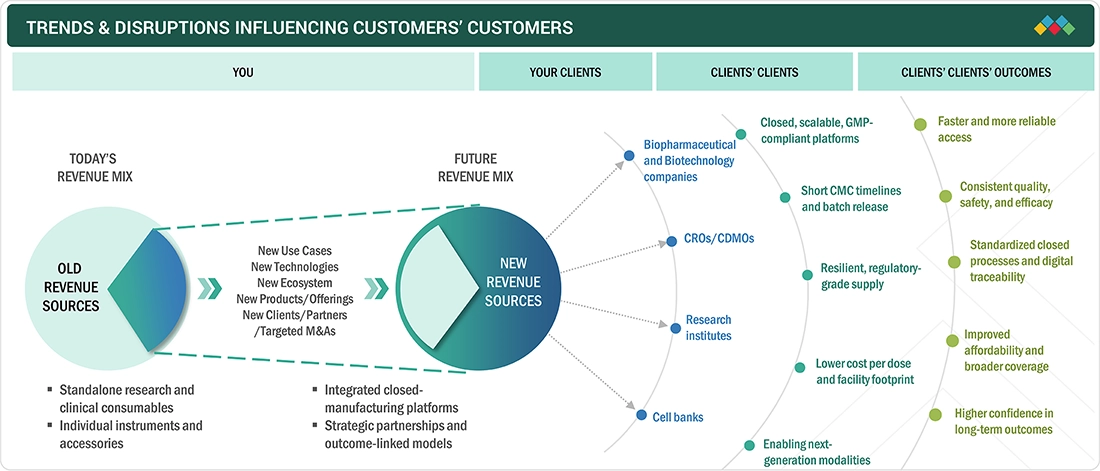
Source: Secondary Research, Interviews with Experts, MarketsandMarkets Analysis
MARKET DYNAMICS
Level
-
Expanding base of approved CGTs and a growing clinical pipeline

Level
-
High therapy cost and uncertain reimbursement limiting commercial volumes
Level
-
Platformized, modular manufacturing solutions for autologous therapies
Level
-
Lack of skilled workforce in CGT manufacturing and automation
Source: Secondary Research, Interviews with Experts, MarketsandMarkets Analysis
Driver: Expanding base of approved CGTs and a growing clinical pipeline
An expanding base of approved cell & gene therapies, together with a rapidly growing clinical pipeline, is a key demand-side driver for the cell therapy technologies products market. As more therapies secure regulatory approval and enter commercial use, treatment centers require reliable, scalable platforms, consumables, and analytical tools to support routine manufacturing and quality control, thereby directly enhancing product uptake. At the same time, the surge in early- and late-stage clinical programs creates sustained demand for flexible, research-to-GMP systems, as sponsors and CDMOs invest in equipment that can be adapted across multiple candidates. The breadth of indications being targeted, from oncology to rare genetic and regenerative disorders, further broadens the installed base of cell processing, gene delivery, and in-process testing technologies. Collectively, this expanding approved portfolio and deep pipeline de-risk the CGT space, attract more capital, and incentivize vendors to innovate end-to-end technology solutions, reinforcing market growth for cell therapy products.
Restraint: High therapy cost and uncertain reimbursement limiting commercial volumes
High therapy cost and uncertain reimbursement structures considerably restrain the growth of the cell therapy technologies market. The manufacturing of cell-based products involves complex processes, specialized facilities, and stringent quality controls, resulting in high production and therapy costs. These expenses often limit patient accessibility, especially in regions with limited healthcare funding. Moreover, reimbursement frameworks for advanced therapies remain underdeveloped, with payers hesitant to cover high-priced, novel treatments due to limited long-term efficacy and cost-benefit data. This uncertainty discourages hospitals and treatment centers from adopting such therapies extensively. Consequently, commercial volumes remain modest despite growing clinical interest and technological advancement, slowing the transition from research-scale adoption to broad clinical use.
Opportunity: Platformized, modular manufacturing solutions for autologous therapies
Platformized, modular manufacturing solutions for autologous therapies create a major opportunity for the cell therapy technologies products market by enabling repeatable, standardized workflows across different patient-specific products. By using configurable, closed and semi-automated modules for key steps such as cell isolation, activation, transduction, expansion and formulation, vendors can offer plug-and-play systems that reduce process variability and manual interventions. Such platform approaches shorten process development timelines, simplify tech transfer from lab to GMP, and make it easier for therapy developers to scale out to larger numbers of patients without fully redesigning the manufacturing set-up each time. In turn, this drives demand for integrated instruments, consumable cartridges, and software suites that can support multiple autologous workflows on the same backbone. As more sponsors seek to commercialize autologous cell therapies, they are likely to favor technology providers offering flexible, modular platforms over bespoke, single-therapy solutions, thereby expanding the addressable market for cell therapy technologies.
Challenge: Lack of skilled workforce in CGT manufacturing and automation
Acute skilled workforce shortages in CGT manufacturing and automation pose a significant challenge for the cell therapy technologies products market because even sophisticated platforms depend on highly skilled operators to run complex, multi-step workflows reliably. Many centers lack personnel experienced in CAR-T and other advanced cell therapy processes, which slows down installation, limits the utilization of installed equipment, and makes it harder for customers to expand their capacity. This skills gap raises the perceived operational risk of adopting new instruments and software, sometimes leading buyers to delay or narrow purchases despite strong clinical demand. To overcome this, vendors are increasingly expected to provide training academies, structured certification programs, and robust remote-support models tied to their product offerings. Suppliers also need to embed guided “process templates,” automated error checks, and decision-support tools into their systems to lower the skill barrier, which increases development and service costs but is becoming essential for commercial success in the cell therapy technologies market.
Cell Therapy Technologies Market: COMMERCIAL USE CASES ACROSS INDUSTRIES
| COMPANY | USE CASE DESCRIPTION | BENEFITS |
|---|---|---|
 |
Implemented Cytiva’s wave/Xuri cell expansion system with Cell bag bioreactors as a closed, rocking-bag platform to expand CD19-targeted CAR-T cells (CTL019) to clinically relevant doses. | Achieved high-fold expansion and viability of CAR-T cells with reduced manual labor versus static flasks; established a scalable, GMP-compatible expansion step that supported technology transfer of the CTL019 process. |
 |
Used Thermo Fisher’s Gibco CTS rotea counterflow centrifugation system with single-use kits to automate buffer exchange, washing, and volume reduction for MSCs and other cell types in small-volume, autologous processes. | Enabled closed, automated handling of delicate cells with high recovery and preserved function; reduced manual, open processing steps and supported a scalable workflow that can translate from academic development to GMP-style manufacturing. |
Logos and trademarks shown above are the property of their respective owners. Their use here is for informational and illustrative purposes only.
MARKET ECOSYSTEM
The cell therapy technologies market operates within a complex ecosystem with a wide array of stakeholders, each playing a crucial role in developing and adopting cell therapy technologies. This ecosystem encompasses manufacturers, suppliers, end users, and regulatory bodies. It evaluates their interactions, dependencies, and contributions within the industry, providing insights into the broader market dynamics and trends. Prominent companies in the market include companies operating for several years that possess diversified product portfolios, strong global sales, and marketing networks.
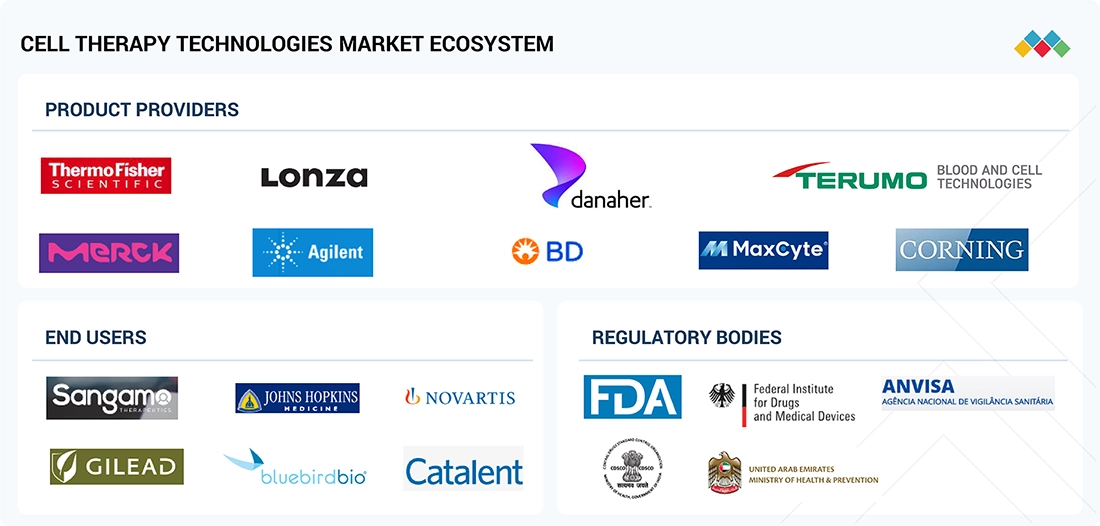
Logos and trademarks shown above are the property of their respective owners. Their use here is for informational and illustrative purposes only.
MARKET SEGMENTS
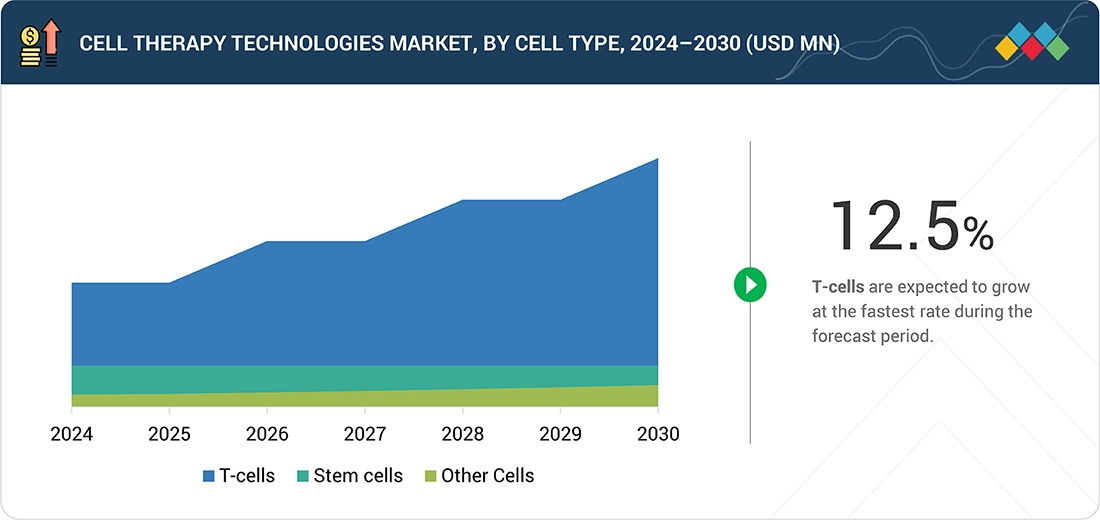
Source: Secondary Research, Interviews with Experts, MarketsandMarkets Analysis
Cell Therapy Technologies Market, By products
As of 2024, the media, sera & reagent segment accounted for the largest share of the cell therapy technologies market and is expected to maintain its lead over the near term, supported by its indispensable role across every stage of cell isolation, expansion, activation, and differentiation workflows. High consumption volumes per batch, frequent replenishment needs, and the requirement for specialized, GMP-grade, serum-free, and xeno-free formulations drive recurring revenue and lock-in for suppliers.
Cell Therapy Technologies Market, By Process
As of 2024, cell processing represented the largest process segment in the cell therapy technologies market and is expected to retain this position, as it encompasses the core value-creating steps of cell selection, activation, gene modification, expansion and formulation that directly determine product yield and quality. Cell processing workflows rely on a wide array of instruments, disposables, and reagents, including separation systems, bioreactors, cell washers, and closed tubing sets, leading to high equipment density and recurring consumable usage per batch.
Cell Therapy Technologies Market, By Cell type
As of 2024, T-cells accounted for the largest share of the cell-type segment in the cell therapy technologies market, reflecting the dominance of CAR T and other engineered T-cell modalities in approved products and late-stage pipelines. These therapies have demonstrated strong clinical efficacy in hematologic malignancies and are expanding into solid tumors through CAR T, TCR, and TIL-based approaches, sustaining high levels of investment and manufacturing activity focused on T cells. T-cell therapies typically require complex gene modification, activation, and expansion workflows, which drive the intensive use of viral vectors, media, bioreactors, and analytical platforms tailored to T-cell biology. As regulators continue to approve new T-cell products and indications, and sponsors scale commercial capacity globally, demand for T-cell–optimized technologies remains the highest among cell types, reinforcing T cells as the leading segment in the cell therapy technologies market.
REGION
Asia Pacific to be fastest-growing region in global cell therapy technologies market during forecast period
The Asia Pacific cell therapy technologies market is expected to register the highest CAGR during the forecast period. This growth is supported by factors such as substantial public and private investment in healthcare and biomanufacturing infrastructure, as well as the growing build-out of CGT research and manufacturing capacity across China, Japan, South Korea, Australia, and Singapore, among other factors.
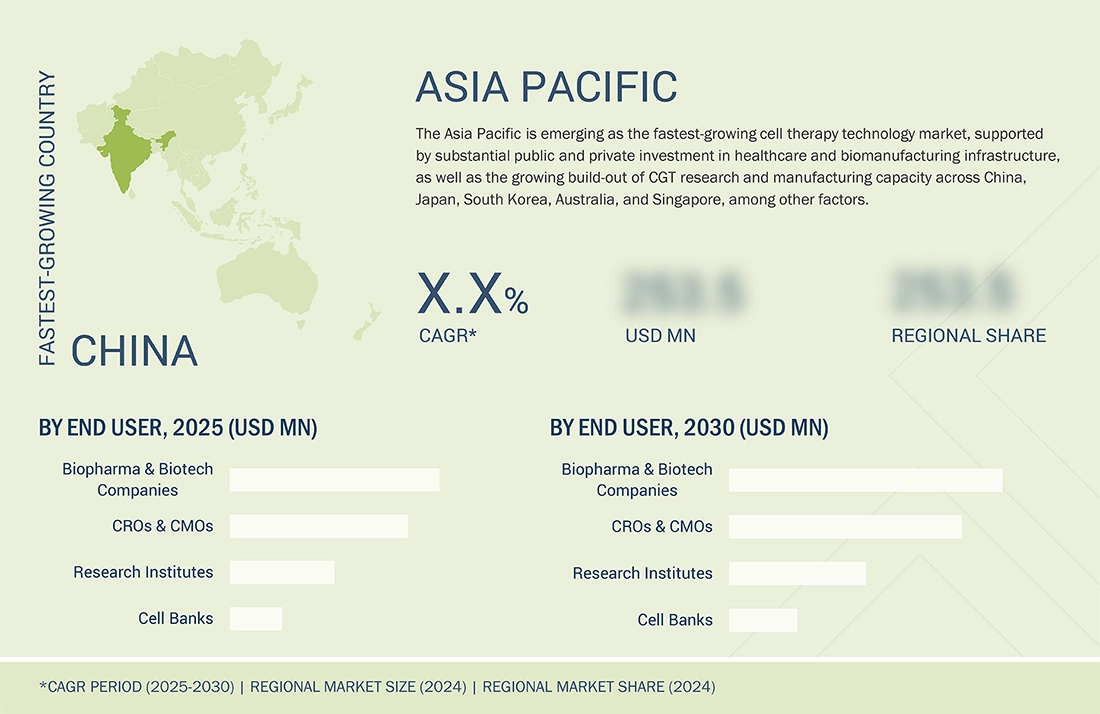
Cell Therapy Technologies Market: COMPANY EVALUATION MATRIX
In the cell therapy technologies market matrix, Danaher (Star) leads with a strong market share and broad solution footprint, underpinned by its Cytiva and Beckman Coulter portfolios that span upstream cell processing, analytics, and digital manufacturing capabilities widely adopted across CGT developers and CDMOs. BD (Emerging Leader) is gaining prominence through its strengths in flow cytometry, cell processing systems, and enabling consumables, increasingly tailored for clinical and commercial cell therapy applications.
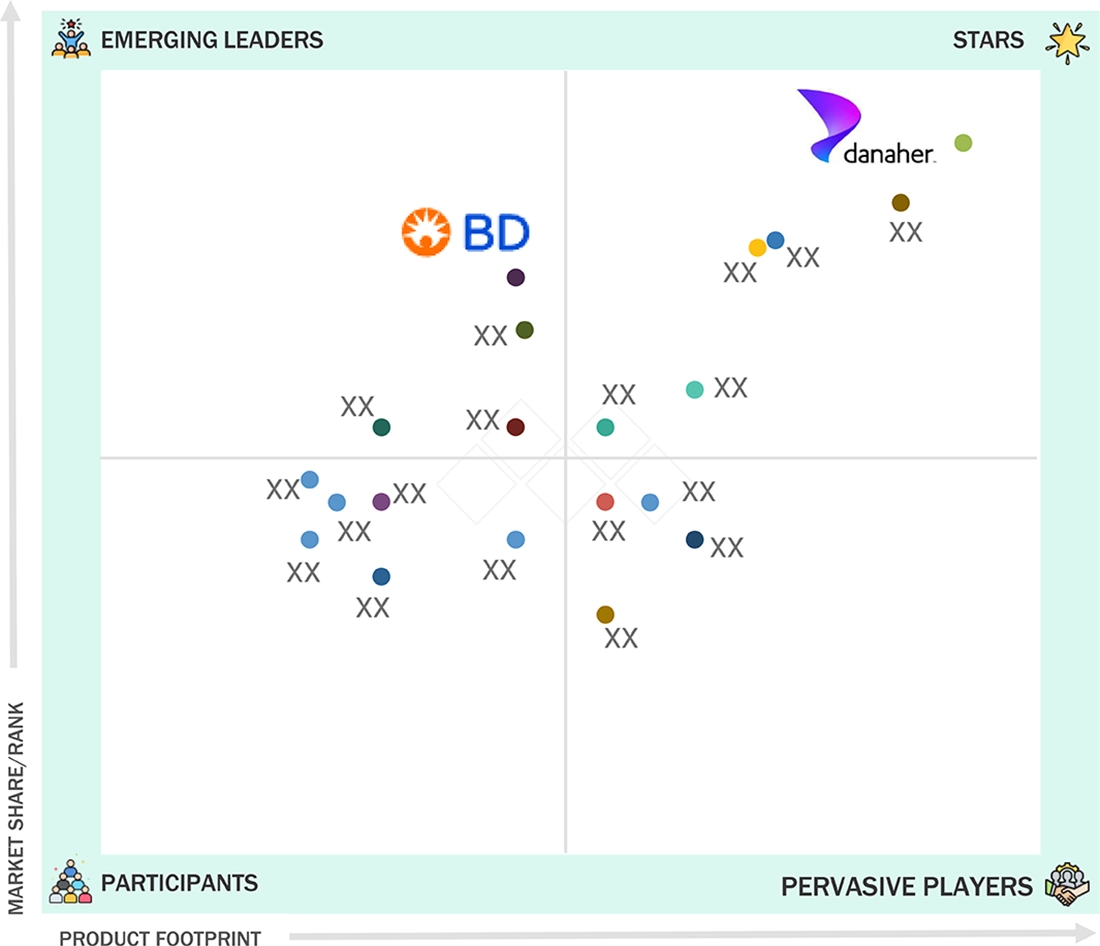
Source: Secondary Research, Interviews with Experts, MarketsandMarkets Analysis
KEY MARKET PLAYERS
- Danaher Corporation (US)
- Merck KGaA (Germany)
- Thermo Fisher Scientific Inc. (US)
- Lonza (Switzerland)
- Sartorius AG (Germany)
- Agilent Technologies, Inc. (US)
- Bio-Techne (US)
- Avantor, Inc. (US)
- Genscript (US)
- Fresenius SE & Co KGAA (Germany)
- BD (US)
- Corning Incorporated (US)
- Terumo Corporation (Japan)
- MaxCyte (US)
- STEMCELL Technologies (Canada)
MARKET SCOPE
| REPORT METRIC | DETAILS |
|---|---|
| Market Size in 2024 (Value) | USD 4.05 Billion |
| Market Forecast in 2030 (Value) | USD 7.91 Billion |
| Growth Rate | CAGR of 12.4% from 2025-2030 |
| Years Considered | 2023-2030 |
| Base Year | 2024 |
| Forecast Period | 2025-2030 |
| Units Considered | Value (USD Billion) |
| Report Coverage | Revenue forecast, company ranking, competitive landscape, growth factors, and trends |
| Segments Covered |
|
| Regions Covered | North America, Europe, Asia Pacific,Latin America, Middle East, Africa |
WHAT IS IN IT FOR YOU: Cell Therapy Technologies Market REPORT CONTENT GUIDE
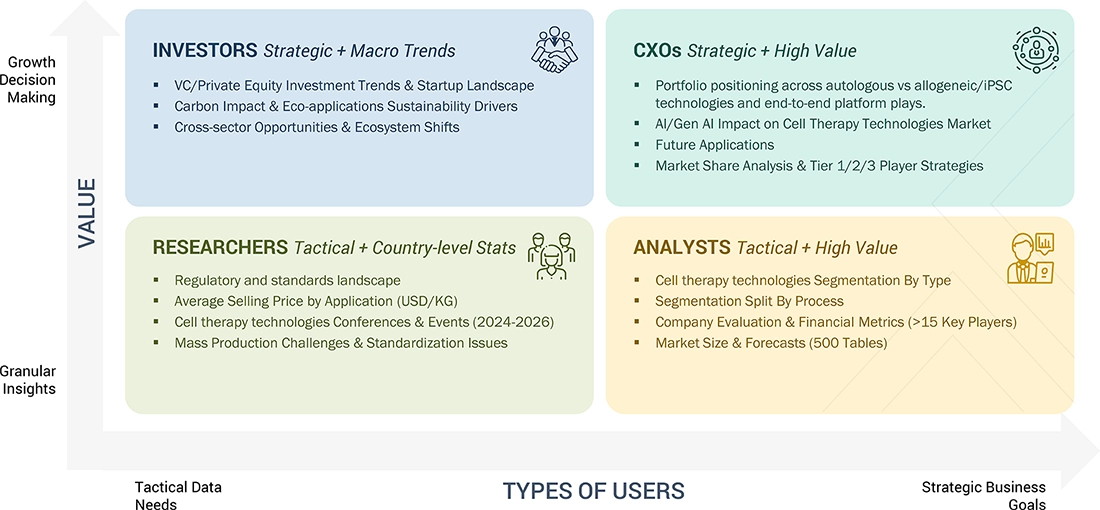
DELIVERED CUSTOMIZATIONS
We have successfully delivered the following deep-dive customizations:
| CLIENT REQUEST | CUSTOMIZATION DELIVERED | VALUE ADDS |
|---|---|---|
| Global CGT CDMO |
|
|
| Cell therapy technology provider (instruments & consumables) |
|
|
RECENT DEVELOPMENTS
- September 2024 : In September 2024, Lonza and Vertex entered a long-term commercial supply agreement for CASGEVY, the world’s first CRISPR/Cas9 gene-edited cell therapy.
- June 2024 : In June 2024, STEMCELL launched the CellPore Transfection System to advance cell engineering research and the development of novel cell therapies to cure disease.
- June 2024 : In June 2024, Thermo Fisher Scientific launched the Thermo Scientific Heracell VIOS 250i AxD CO2 Incubators to deliver new features compatible with lab automation, supporting emerging automated cell therapy production processes.
Table of Contents

- 4.1 INTRODUCTION
-
4.2 MARKET DYNAMICSDRIVERSRESTRAINTSOPPORTUNITIESCHALLENGES
- 4.3 UNMET NEEDS AND WHITE SPACES
- 4.4 INTERCONNECTED MARKETS AND CROSS-SECTOR OPPORTUNTIES
- 4.5 STRATEGIC MOVES BY TIER-1/2/3 PLAYERS
-
5.1 PORTER’S FIVE FORCES ANALYSISTHREAT OF NEW ENTRANTSTHREAT OF SUBSTITUTESBARGAINING POWER OF SUPPLIERSBARGAINING POWER OF BUYERSINTENSITY OF COMPETITION RIVALRY
-
5.2 MACROECONOMIC OUTLOOKGDP TRENDS AND FORECASTTRENDS IN GLOBAL CELL THERAPY TECHNOLOGY MARKETTRENDS IN GLOBAL HEALTHCARE/PHARMA INDUSTRYTRENDS IN GLOBAL CELL THERAPY TECHNOLOGY INDUSTRY
- 5.3 VALUE CHAIN ANALYSIS
-
5.4 ECOSYSTEM ANALYSISEMERGING BUSINESS MODELS AND ECOSYSTEM SHIFTS
-
5.5 PRICING ANALYSISAVERAGE SELLING PRICE TREND OF KEY PLAYERS, BY PRODUCT (2022-2024)AVERAGE SELLING PRICE TREND, BY REGION (2022-2024)
-
5.6 TRADE ANALYSIS (2020-2024)IMPORT SCENARIO (HS CODE 8543)EXPORT SCENARIO (HS CODE 8543)
- 5.7 KEY CONFERENCES AND EVENTS, 2025–2026
- 5.8 TRENDS/DISRUPTIONS IMPACTING CUSTOMER BUSINESS
-
5.9 INVESTMENT AND FUNDING SCENARIOVC/PRIVATE EQUITY INVESTMENT TRENDS & STARTUP LANDSCAPE
-
5.10 IMPACT OF 2025 US TARIFF – CELL THERAPY TECHNOLOGIES MARKETINTRODUCTIONKEY TARIFF RATESPRICE IMPACT ANALYSISIMPACT ON COUNTRIES/REGIONS- US- EUROPE- APACIMPACT ON END-USE INDUSTRIES
-
6.1 KEY EMERGING TECHNOLOGIESMAGNETIC-ACTIVATED CELL SORTINGCRYOPRESERVATION
-
6.2 COMPLEMENTARY TECHNOLOGIESAUTOMATION AND SCALABILITYAI & ML
-
6.3 ADJACENT TECHNOLOGIESNANOTECHNOLOGYIMMUNOTHERAPY PLATFORMS
- 6.4 TECHNOLOGY/PRODUCT ROADMAP
- 6.5 PATENT ANALYSIS
-
6.6 IMPACT OF AI/GEN AI ON CELL THERAPY TECHNOLOGIES MARKETTOP USE CASES AND MARKET POTENTIALCASE STUDIES OF AI IMPLEMENTATION IN THE CELL THERAPY TECHNOLOGIES MARKETINTERCONNECTED ADJACENT ECOSYSTEM AND IMPACT ON MARKET PLAYERSCLIENTS’ READINESS TO ADOPT GENERATIVE AI IN CELL THERAPY TECHNOLOGIES MARKET
-
7.1 REGIONAL REGULATIONS AND COMPLIANCEREGULATORY BODIES, GOVERNMENT AGENCIES, AND OTHER ORGANIZATIONSINDUSTRY STANDARDS
- 7.2 SUSTAINABILITY IMPACT AND REGULATORY POLICY INITIATIVES
- 7.3 CERTIFICATIONS, LABELING, ECO-STANDARDS
- 8.1 DECISION-MAKING PROCESS
- 8.2 BUYER STAKEHOLDERS AND BUYING EVALUATION CRITERIA
- 8.3 ADOPTION BARRIERS & INTERNAL CHALLENGES
- 8.4 UNMET NEEDS FROM VARIOUS END-USE INDUSTRIES
- 8.5 MARKET PROFITABILITY
- 9.1 INTRODUCTION
- 9.2 MEDIA, SERA, REAGENT
-
9.3 CELL THERAPY EQUIPMENTCELL PROCESSING EQUIPMENTSINGLE-USE EQUIPMENTOTHER CELL THERAPY EQUIPMENT
- 9.4 SYSTEMS & SOFTWARE
- 9.5 CELL CULTURE VESSELS
- 9.6 CELL ENGINEERING PRODUCTS
- 9.7 OTHER PRODUCTS
- 10.1 INTRODUCTION
-
10.2 CELL PROCESSINGCELL EXPANSIONCELL ISOLATIONCELL CHARACTERIZATIONCELL COLLECTION
- 10.3 CELL PRESERVATION
- 10.4 CELL HANDLING
- 10.5 CELL DISTRIBUTION
- 11.1 INTRODUCTION
- 11.2 T CELLS
- 11.3 STEM CELLS
- 11.4 OTHER CELLS
- 12.1 INTRODUCTION
- 12.2 CANCER
- 12.3 CARDIOVASCULAR DISEASE
- 12.4 ORTHOPEDIC DISORDERS
- 12.5 AUTOIMMUNE DISEASES
- 12.6 OTHER INDICATIONS
- 13.1 INTRODUCTION
- 13.2 BIOPHARMACEUTICAL & BIOTECHNOLOGY COMPANIES
- 13.3 CROS & CMOS
- 13.4 RESEARCH INSTITUTES
- 13.5 CELL BANKS
- 14.1 INTRODUCTION
-
14.2 NORTH AMERICAUSCANADAMACROECONOMIC OUTLOOK OF NORTH AMERICA
-
14.3 EUROPEGERMANYUKFRANCEITALYSPAINREST OF EUROPEMACROECONOMIC OUTLOOK OF EUROPE
-
14.4 ASIA PACIFICCHINAJAPANINDIAAUSTRALIASOUTH KOREAREST OF ASIA PACIFICMACROECONOMIC OUTLOOK OF ASIA PACIFIC
-
14.5 LATIN AMERICABRAZILMEXICOREST OF LATIN AMERICAMACROECONOMIC OUTLOOK OF LATIN AMERICA
-
14.6 MIDDLE EASTGCC- UAE- SAUDI ARABIA- REST OF GCCREST OF MIDDLE EASTMACROECONOMIC OUTLOOK OF MIDDLE EAST
-
14.7 AFRICAMACROECONOMIC OUTLOOK OF AFRICA
- 15.1 OVERVIEW
- 15.2 KEY PLAYERS STRATEGY/ RIGHT TO WIN
- 15.3 REVENUE ANALYSIS
- 15.4 MARKET SHARE ANALYSIS
-
15.5 COMPANY EVALUATION MATRIX: KEY PLAYERSSTARSEMERGING LEADERSPERVASIVE PLAYERSPARTICIPANTSCOMPANY FOOTPRINT: KEY PLAYERS, 2024- COMPANY FOOTPRINT- REGION FOOTPRINT- PRODUCT FOOTPRINT- CELL TYPE FOOTPRINT- APPLICATION FOOTPRINT
-
15.6 COMPANY EVALUATION MATRIX: START-UPS/SMES, 2024PROGRESSIVE COMPANIESRESPONSIVE COMPANIESDYNAMIC COMPANIESSTARTING BLOCKSCOMPETITIVE BENCHMARKING: STARTUPS/SMES, 2024- DETAILED LIST OF KEY STARTUPS/ SMES- COMPETITIVE BENCHMARKING OF KEY EMERGING PLAYERS/STARTUPS
- 15.7 BRAND COMPARISON
- 15.8 VALUATION AND FINANCIAL METRICS
-
15.9 COMPETITIVE SCENARIOPRODUCT LAUNCHESDEALSOTHER DEVELOPMENTS
-
16.1 KEY COMPANIESDANAHER CORPORATIONMERCK KGAATHERMO FISHER SCIENTIFIC, INC.LONZASARTORIOUS AGAGILENT TECHNOLOGIES, INCAVANTOR,INCFRESENIUS SE & CO. KGAABECTON, DICKINSON AND COMPANYCORNING INCORPORATEDTERUMO CORPORATIONBIO-TECHNEGENSCRIPTMAXCYTESTEMCELL TECHNOLOGIES
-
16.2 OTHER PLAYERSOXFORD BIOMEDICA PLC.ROOSTERBIO, INC.TRAKCEL.L7 INFORMATICS, INCMILTENYI BIOTECREPLIGEN CORPORATIONMAK SYSTEMORIGEN BIOMEDICAL, INCIXCELLS BIOTECHNOLOGIESKÖRBER AG
-
17.1 RESEARCH DATASECONDARY DATA- Key sources of secondary data- Key objectives of secondary dataPRIMARY DATA- Breakdown of primaries- Key objectives of primary research
-
17.2 MARKET SIZE ESTIMATIONGLOBAL PREIMPLANTATION GENETIC TESTING MARKET SIZE ESTIMATION- Company Revenue Analysis (Bottom-up Approach)- MnM Repository Analysis- Secondary Analysis- Primary ResearchSEGMENTAL MARKET SIZE ESTIMATION (TOP-DOWN APPROACH)
- 17.3 MARKET GROWTH RATE PROJECTIONS
- 17.4 DATA TRIANGULATION
- 17.5 RESEARCH ASSUMPTIONS
- 17.6 RESEARCH LIMITATIONS AND RISK ASSESSMENT
- 18.1 DISCUSSION GUIDE
- 18.2 KNOWLEDGE STORE: MARKETSANDMARKETS’ SUBSCRIPTION PORTAL
- 18.3 AVAILABLE CUSTOMIZATIONS
- 18.4 RELATED REPORTS
- 18.5 AUTHOR DETAILS
Methodology
This research study utilized extensive secondary sources, directories, and databases to identify and collect valuable information for analyzing the global cell therapy technologies market. In-depth interviews were conducted with various primary respondents, including key industry participants, subject-matter experts (SMEs), C-level executives of key market players, and industry consultants, to gather and verify critical qualitative and quantitative information and assess the market's growth prospects. The global market size estimated through secondary research was then triangulated with inputs from primary research to arrive at the final market size.
Secondary Research
Secondary research was primarily used to identify and collect information for the comprehensive, technical, market-oriented, and commercial study of the cell therapy technologies market. The secondary sources used for this study include FDA (US Food and Drug Administration), EMA (European Medicines Agency), NIH (National Institutes of Health), ClinicalTrials.gov, PMDA (Pharmaceuticals and Medical Devices Agency, Japan), MHRA (Medicines and Healthcare products Regulatory Agency, UK), European Society of Gene and Cell Therapy (ESGCT), California Institute for Regenerative Medicine (CIRM), World Health Organization (WHO), International Society for Cell & Gene Therapy (ISCT), CBER (Center for Biologics Evaluation and Research), NIH Regenerative Medicine Program, National Medical Products Administration (NMPA), China, Health Canada – Biologics and Genetic Therapies Directorate (BGTD), Eurostat, Factiva, and GLOBOCAN, ScienceDirect; research journals; corporate filings, such as annual reports, SEC filings, investor presentations, and financial statements; press releases; and trade, business, and professional associations, among others. These sources were also utilized to gather key information about major players, market classification, and segmentation, as well as industry trends, regional/country-level markets, market developments, and technological perspectives.
Primary Research
After acquiring foundational knowledge about the global cell therapy technologies market through secondary research, extensive primary research was conducted. Multiple interviews were held with market experts from the demand side, including representatives from biopharmaceutical & biotechnology companies, CROs and CMOs, research institutes, and cell banks. Additionally, experts from the supply side were interviewed, including C-level and D-level executives, product managers, and marketing and sales managers from key manufacturers, distributors, and channel partners.
These interviews spanned six major regions: North America, Europe, Asia Pacific, Latin America, the Middle East, and Africa. Approximately 70% of the primary interviews were conducted with supply-side participants, while the remaining 30% were with demand-side participants. The primary data was collected through various methods, including questionnaires, emails, online surveys, personal interviews, and telephone interviews.
The following is a breakdown of the primary respondents:
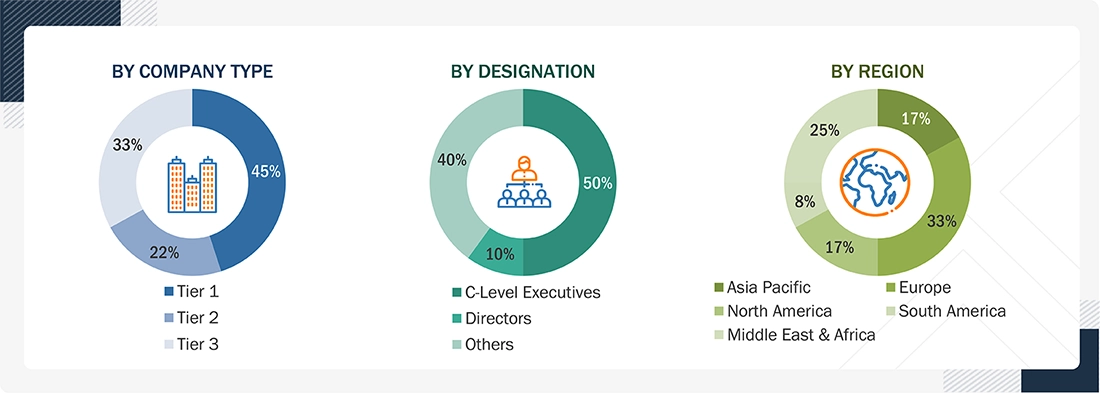
To know about the assumptions considered for the study, download the pdf brochure
Market Size Estimation
Both top-down and bottom-up approaches were used to estimate and validate the total size of the cell therapy technologies market. These methods were also used extensively to estimate the size of various market segments. The research methodology used to estimate the market size includes the following:
After determining the overall market size through the estimation process, the total market was divided into several segments and subsegments.

Data Triangulation
After determining the market size through the estimation process explained above, the total market was divided into several segments and subsegments. To complete the overall market engineering process and obtain precise statistics for all segments and subsegments, data triangulation and market breakdown procedures were employed, as applicable. The data was triangulated by studying various factors and trends from both the demand and supply sides.
Market Definition
Cell therapy is a transformative area that represents a groundbreaking advancement in modern medicine, leveraging living cells to repair, replace, or regenerate damaged tissues and treat a wide range of diseases. This innovative approach involves introducing functional cells into a patient’s body to restore health, offering solutions for conditions that were once considered untreatable. With applications spanning autologous therapies, which utilize a patient’s cells, and allogeneic therapies, offering scalable off-the-shelf solutions, cell therapy is transforming healthcare delivery. The report encompasses a range of media, sera, reagents, cell engineering products, cell therapy equipment, software, and other products utilized at various stages of cell therapy, including cell collection, manufacturing, expansion, and storage.
Stakeholders
- Cell therapy product manufacturers, suppliers, and processors
- Distributors and suppliers of cell therapy products
- Biotechnology and biopharmaceutical companies
- Contract manufacturing organizations (CMOs)
- Suppliers and distributors of pharmaceutical products
- Research and development (R&D) companies
- Pharmaceutical/medical associations
- Trade associations and industry bodies
- Regulatory bodies and government agencies
- Research institutes and government organizations
- Venture capitalists and investors
- Business research and consulting service providers
- Market research and consulting firms
Report Objectives
- To define, describe, and forecast the cell therapy technologies market based on product, process, cell type, application, end user, and region
- To provide detailed information regarding the major factors influencing market growth (such as drivers, restraints, opportunities, and challenges)
- To strategically analyze micromarkets1 with respect to individual growth trends, prospects, and contributions to the overall cell therapy technologies market
- To analyze the opportunities in the market for stakeholders and provide details of the competitive landscape for market leaders
- To forecast the size of the market segments with respect to six main regions: North America, Europe, the Asia Pacific, Latin America, the Middle East, and Africa
- To profile the key players in the global cell therapy technologies market and comprehensively analyze their product portfolios, market positions, and core competencies2
- To track and analyze competitive developments such as product launches, acquisitions, partnerships, expansions, agreements, and collaborations in the cell therapy technologies market
- To benchmark players within the cell therapy technologies market using the ‘Company Evaluation Matrix' framework, which analyzes market players based on various parameters within the broad categories of business and business strategy
Need a Tailored Report?
Customize this report to your needs
Get 10% FREE Customization
Customize This ReportPersonalize This Research
- Triangulate with your Own Data
- Get Data as per your Format and Definition
- Gain a Deeper Dive on a Specific Application, Geography, Customer or Competitor
- Any level of Personalization
Let Us Help You
- What are the Known and Unknown Adjacencies Impacting the Cell Therapy Technologies Market
- What will your New Revenue Sources be?
- Who will be your Top Customer; what will make them switch?
- Defend your Market Share or Win Competitors
- Get a Scorecard for Target Partners
Custom Market Research Services
We Will Customise The Research For You, In Case The Report Listed Above Does Not Meet With Your Requirements
Get 10% Free Customisation








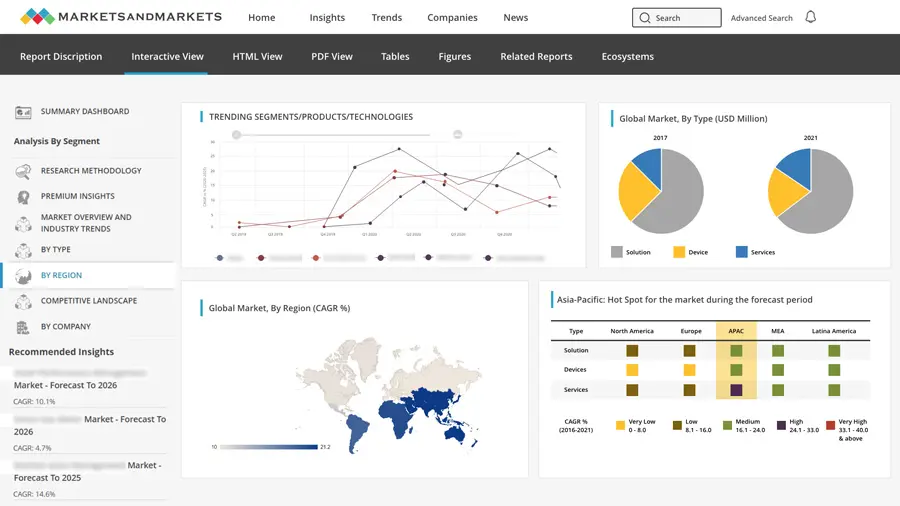
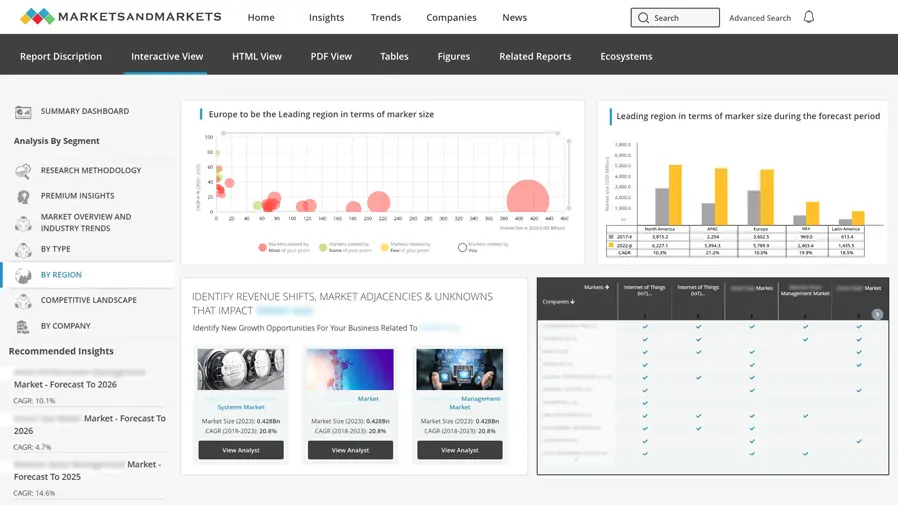
Growth opportunities and latent adjacency in Cell Therapy Technologies Market